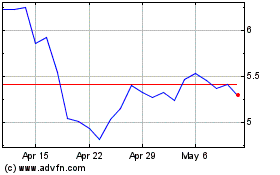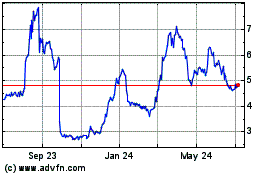Capricor Therapeutics, Inc. (NASDAQ: CAPR) will provide a
presentation at the 2018 Cell & Gene Meeting on the Mesa today
on its cell therapy, CAP-1002, which is currently in clinical
development for the treatment of Duchenne muscular dystrophy. It
will also discuss its exosome-based therapy, CAP-2003, and the
potential for using exosomes, which many consider to be the next
generation platform in regenerative medicine, as a therapeutic and
as a potential vehicle for delivering therapies to cells in the
human body.
In addition, during the three-day conference in
La Jolla, CA, Capricor will provide a poster presentation on a
pre-clinical study which found that extracellular vesicles, or
exosomes, were the active component of CAP-1002. Exosomes are
nano-sized, membrane-enclosed vesicles, or bubbles, that are
secreted by cells and contain bioactive molecules, including
proteins, RNAs and microRNAs. They serve as messengers to regulate
the functions of neighboring cells.
The details of the presentations are:
| What: |
Capricor Presentation by
Capricor CEO Linda Marbán, Ph.D. |
| When: |
11:30-11:45 a.m. PT,
Wednesday, Oct. 3 |
| Location: |
La Jolla Ballroom 2 |
| |
Estancia La Jolla Hotel
& Spa |
| |
9700 North Torrey Pines
Road |
| |
La Jolla, CA 92037 |
A live video webcast of the presentation will be available
at http://www.meetingonthemesa.com/webcast and will also be
published on the conference website shortly after the event.
| What: |
Capricor Poster
Presentation at the Scientific Symposium |
| Title: |
Assessing Biological
Mechanisms of Action of Soluble Paracrine Factors and Extracellular
Vesicles Secreted by Human Cardiosphere-Derived Cells |
| When: |
9 a.m. to 5 p.m. PT,
Friday, Oct. 5 |
| Location: |
Salk Institute for
Biological Studies |
| |
10010 North Torrey Pines
Road |
| |
La Jolla, CA 92037 |
The poster will be available at the Events & Presentations
section of Capricor’s website on Friday, Oct. 5.
The poster will report on a pre-clinical study
that assessed the biological mechanisms of action of paracrine
factors and extracellular vesicles, also known as exosomes,
secreted by cardiosphere derived cells (CDCs), the active component
of Capricor’s novel cell therapy, CAP-1002. The poster showed that
growth factors released by CDCs are able to activate survival
signals in treated cells. However, Capricor also reported that the
exosomes were responsible for CAP-1002’s immunomodulatory
effects.
About Capricor Therapeutics
Capricor Therapeutics, Inc. (NASDAQ: CAPR) is a
clinical-stage biotechnology company developing biological
therapies for Duchenne muscular dystrophy (DMD) and other rare
diseases. Capricor's lead candidate, CAP-1002, is a cell-based
candidate currently in clinical development for the treatment of
DMD. Capricor is also exploring the potential of CAP-2003, a
cell-free, extracellular vesicle-based candidate, to treat a
variety of disorders. For more information, visit
www.capricor.com.
About CAP-1002
CAP-1002 consists of allogeneic
cardiosphere-derived cells, or CDCs, a unique population of cells
that contains cardiac progenitor cells. CAP-1002 has been shown to
exert potent immunomodulatory activity and alters the immune
system's activity to encourage cellular regeneration. CDCs have
been the subject of over 100 peer-reviewed scientific publications
and have been administered to approximately 140 human subjects
across several clinical trials.
About CAP-2003
CAP-2003 is being developed as a next-generation
therapeutic platform in regenerative medicine. CAP-2003 is
comprised of nano-sized extracellular vesicles, including exosomes
and microvesicles, derived from human CDCs, which exert
anti-inflammatory, pro-angiogenic, anti-apoptotic, and
anti-fibrotic effects. CAP-2003 contains several characteristic
lipids, proteins, and RNA molecules (e.g., microRNAs). They act as
messengers to regulate the functions of neighboring cells.
Pre-clinical research has shown that exogenously-administered
extracellular vesicles can direct or, in some cases, re-direct
cellular activity, supporting their therapeutic potential. Their
size, ease of crossing cell membranes and ability to communicate in
native cellular language make them an exciting class of potential
therapeutic agents.
About the 2018 Cell &
Gene Meeting on the Mesa
The Cell & Gene Meeting on the Mesa is a
three-day conference combining discussions between key opinion
leaders, senior executives and top academic researchers. The
program also includes 65+ presentations by the field’s most
promising companies and 35 poster abstracts by leading scientists
from around the globe. For more information, please visit
http://www.meetingonthemesa.com/
Cautionary Note Regarding
Forward-Looking Statements
Statements in this press release regarding the
efficacy, safety, and intended utilization of Capricor's product
candidates; the initiation, conduct, size, timing and results of
discovery efforts and clinical trials; the pace of enrollment of
clinical trials; plans regarding regulatory filings, future
research and clinical trials; regulatory developments involving
products, including the ability to obtain regulatory approvals or
otherwise bring products to market; plans regarding current and
future collaborative activities and the ownership of commercial
rights; scope, duration, validity and enforceability of
intellectual property rights; future royalty streams, expectations
with respect to the expected use of proceeds from the recently
completed offerings and the anticipated effects of the offerings,
and any other statements about Capricor's management team's future
expectations, beliefs, goals, plans or prospects constitute
forward-looking statements within the meaning of the Private
Securities Litigation Reform Act of 1995. Any statements that are
not statements of historical fact (including statements containing
the words "believes," "plans," "could," "anticipates," "expects,"
"estimates," "should," "target," "will," "would" and similar
expressions) should also be considered to be forward-looking
statements. There are a number of important factors that could
cause actual results or events to differ materially from those
indicated by such forward-looking statements. More information
about these and other risks that may impact Capricor's business is
set forth in Capricor's Annual Report on Form 10-K for the year
ended December 31, 2017 as filed with the Securities and Exchange
Commission on March 22, 2018, in its Registration Statement on Form
S-3, as filed with the Securities and Exchange Commission on
September 28, 2015, together with the prospectus included therein
and prospectus supplements thereto and in its Quarterly Report on
Form 10-Q for the quarter ended June 30, 2018, as filed with the
Securities and Exchange Commission on August 13, 2018. All
forward-looking statements in this press release are based on
information available to Capricor as of the date hereof, and
Capricor assumes no obligation to update these forward-looking
statements.
CAP-1002 is an Investigational New Drug and is
not approved for any indications. CAP-2003 has not yet been
approved for clinical investigation.
For more information, please contact:
AJ Bergmann, Chief Financial Officer
+1-310-358-3200
abergmann@capricor.com
Capricor Therapeutics (NASDAQ:CAPR)
Historical Stock Chart
From Mar 2024 to Apr 2024

Capricor Therapeutics (NASDAQ:CAPR)
Historical Stock Chart
From Apr 2023 to Apr 2024
